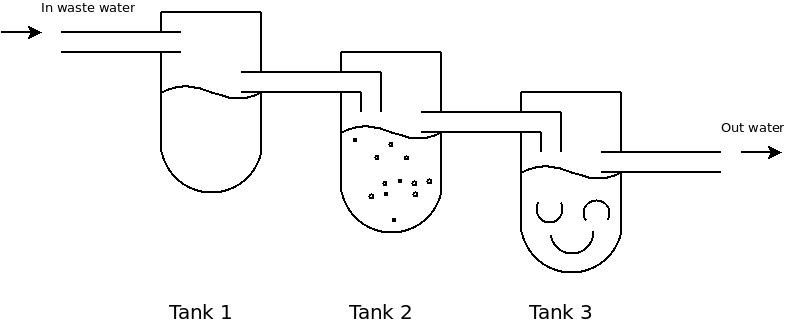Indicators on Residential Water Treatment System You Need To Know
Table of ContentsMore About Residential Water Treatment SystemThe smart Trick of Residential Water Treatment System That Nobody is Talking AboutWhat Does Residential Water Treatment System Do?6 Easy Facts About Residential Water Treatment System Explained

on the other hand, originates from production, commercial and also business activities brought and also has a totally various structure than sewer water. How does it function? The primary step in this water therapy plant is that the wastewater drains to the plant with the help of gravity via the main sewer system.
In this stage, the water moves via the gravel chamber to eliminate any kind of grit. The water after that relocates to the bar screens which remove large items.
This is after that removed from the container as well as disposed of at the dump. Next comes the sedimentation phase, additionally referred to as the primary therapy. In this stage, the water flows to the main settling containers, likewise called pre-settling containers. These tanks have receptacles which are located in the base of the container where water streams through.
Some Known Details About Residential Water Treatment System
These settling tanks make it possible for the sludge to clear up and afterwards relocates to food digestion containers. In the food digestion storage tanks, the sludge is warmed and also mixed. Another vital point that occurs here is the production of biogas, which the wastewater therapy plants can recycle, in the production of electric or thermal energy which is another huge benefit to the environment.

The last step in wastewater treatment is assessment. This inspection entails inspecting the contamination level of the water treated as well as making certain it abides with the greatest standards in order to be launched or recycled for domestic or commercial functions. residential water treatment system. Applications: Most oil refineries or petrochemical as well as chemical sectors produce a huge amount of wastewater and need on-site wastewater treatment plants.
The wastewater below flows through screens and also right into negotiation basins that can get debris in huge amounts. It serves as a pre-treatment as mentioned above as it occurs before three even more hostile phases- primary, additional and tertiary treatment. Primary Therapy Throughout this stage, the wastewater moves right into the clarifiers.
How Residential Water Treatment System can Save You Time, Stress, and Money.
It is the layout of these containers that result in clearing up, that is, the natural strong matter accumulates at the bottom of the storage tank while the lighter matter drifts to the leading coming to be simpler for elimination. The organic issue that works out at the bottom is called a key sludge blanket.
Secondary Therapy This therapy phase is composed of cardio oygenation. When this air moves via the aerators, the little openings existing, transform them right into bubbles and also they get mixed with the water column.
This RAS goes back right into the key clarification storage tank and the germs in it helps in damaging down any raw material in the sewer. As soon as RAS has actually entirely undergone both the key and additional clarification basins continually, i. e several times, it is become waste-activated sludge (WAS). The WAS then does not return to the key clarification container but rather moves to the covered containers, also recognized as aerobic sludge digesters.
The continuing to be sludge moves to the dewatering center that has dewatering storage tanks where the plant utilizes belt presses to press important link any remaining water out of the sludge. Tertiary Treatment Tertiary treatment complies with the process of both primary and also additional procedures yet also additionally entails mechanical and photochemical procedures.
The Ultimate Guide To Residential Water Treatment System
The purpose of this is to eliminate as much solid physical issues as feasible before sending out the effluent for more treatment. Below chemicals are included to damage down any kind of strong and also chemical waste.
There are two types of materials- one is an anion one while the other is a cation one. These previous materials launch hydroxyl ions which are adversely charged while the cation resins release hydrogen ions that are positively here are the findings billed. The cation-exchange resins bring about conditioning of water, the anion-exchange cause the removal of nitrate from wastewater and the mix of both the anion and also cation exchange eliminates practically every ionic impurity present in the feed water with a process called deionization (residential water treatment system).
Applications: Demineralization results in the full removal of minerals from the water and is typically used in markets that require water with high levels of pureness, as an example- makeup or feed water in high-pressure central heating boilers, the food and also beverage sector, and also procedure streams used in the manufacturing of electronic devices. They are also made use of in markets for the generation of vapor, power as well as cooling.
Reverse Osmosis (RO) Water Therapy The concept of reverse osmosis (RO) operates on the filtration technique that results in the elimination of a lot of pollutants this post as well as contaminations from wastewater by applying pressure to it when it is on one side of a membrane. How does it function? This water treatment plant functions by utilizing a high-pressure pump that enhances the stress on the salt side of the RO as well as compels the water throughout the semipermeable RO membrane (which allows some atoms as well as particles to pass however not others), leaving almost 95%-99% of liquified salts in the deny stream.